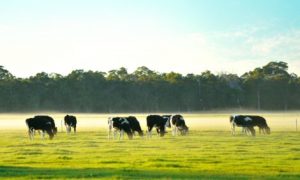
Further milk supply growth and farmer margin gains are expected in 2025, according to a new Rabobank report.
In its Global dairy quarterly Q4 2024: A period of prosperity report, Rabobank expects milk supply growth from the biggest exporting regions in the second half of 2024.
Growth is expected to continue into 2025, with gains anticipated in all major regions for the first time since 2020.
Rising farm gate milk prices and favourable feed costs are improving dairy farm margins, while global dairy demand remains mixed amid economic pressures.
“RaboResearch expects 0.5 per cent milk supply growth from the ‘big seven’ [the EU, US, New Zealand, Australia, Brazil, Argentina and Uruguay] export regions in the second half of 2024, driven by significant seasonal peaks in Oceania,” RaboResearch senior dairy analyst Michael Harvey said.
“Supply growth will maintain its momentum in 2025, with gains expected in all ‘big seven’ exporting regions for the first time since 2020.”
RaboResearch forecasts milk supply growth of 0.8 per cent in 2025 with affordable feed costs and improved weather supporting this growth.
Firmer commodity prices have flowed through to dairy farmers in export regions, with local farm gate prices improving considerably in the second half of 2024.
In parts of Europe and New Zealand, farm gate milk prices are nearing 2022 record highs. Rising milk prices and affordable feed have improved dairy farm margins, which will likely expand further in 2025.
Mr Harvey said Australian consumers were seeing some relief in dairy product prices.
According to the Australian Bureau of Statistics’ Consumer Price Index (CPI) data, there are emerging signs of deflation. In September, cheese was deflationary for the first time since 2021 (-2.2 per cent). Retail prices of private label milk in some supermarkets were lowered in Q4 2024.
“Dairy import volumes for Australia have fallen so far in 2024,” he said.
“Between January and September, butter import volumes were down 22 per cent (-29,300mt) and cheese imports were down 10 per cent (-75,800mt).”
The Australian export sector had a solid season in 2023-24, Mr Harvey said.
“For the full season ending June 30, Australian dairy exports were 705,000mt, up one per cent year-on-year.
“Cheese export volumes were buoyant, as were SMP and butter trade. Soft Chinese demand resulted in a 24 per cent drop in Australia’s liquid milk exports.
“Export volumes started the 2024-25 season on a high. Trade volumes increased 4.5 per cent year-on-year during Q3, with further strong gains in butter, SMP and cheese exports expected.”
Mr Harvey said with the election of Donald Trump as US president, markets were watching for the risk of rising US protectionism and potential trade tensions.
“A re-emergence of tariffs could disrupt dairy trade flows, while the threat of mass deportations could disrupt US farm labour availability.”
You can now read the most important #news on #eDairyNews #Whatsapp channels!!!
🇺🇸 eDairy News INGLÊS: https://whatsapp.com/channel/0029VaKsjzGDTkJyIN6hcP1K

























